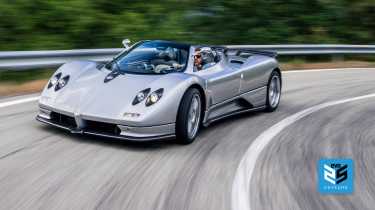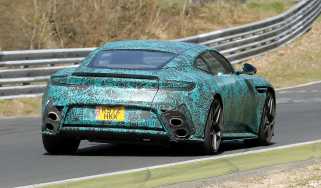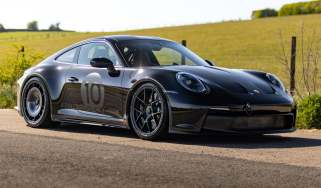Pagani Zonda 760RS - the most extreme Zonda
Pagani's new 760RS is effectively the track-only Zonda R made road legal. The wildest Zonda yet?
Some people are never satisfied. Just ask Horacio Pagani, who was convinced that the £1.5m, 669bhp Zonda Cinque Roadster would be the last road-going Zonda the Pagani factory would ever produce. But he hadn’t counted on the degree of pestering he would receive from wealthy Pagani clientele for a road-going version of the even more extreme, but track-use only, 739bhp Zonda R. For the ten customers who have bought a Zonda R so far, gaining access to a circuit every time they fancy going for a spin is obviously not a problem, but for the rest of the world’s supercar-buying population, you could argue that the Zonda R is a tad compromised. That’s why Horacio eventually started to consider building a Zonda R for the road and, together with a small group of equally fanatical engineers, has spent the last year developing the car you see here, the mighty Zonda 760RS – or ‘La Bestia’ (The Beast) as it’s affectionately known at Pagani. I first got wind of this car completely by accident while visiting the Pagani factory in Modena last year. I was walking through the workshop when I spotted the well-used Zonda development car hiding in the corner. But something looked different. At first I couldn’t work out what it was, then it dawned on me: the back of the gearbox casing was protruding out of the rear valance further than normal, just like it does on a Ferrari 288 GTO. But why was there a new type of gearbox hanging out the back of this development hack? I’d understood that all Zonda development had ceased when the focus switched to bringing its successor, the Huayra, towards production reality… After plenty of arm-twisting over the coming months, I finally got an answer. Apparently it all came about after AMG found a way of increasing the output of the 7.3-litre V12 engine it makes for the Zonda from the Cinque’s 669bhp to 750bhp (760 PS). Unbeknown to the outside world, Horacio had previously decided that if Pagani was ever to build a Zonda R for the road then the 7.3 V12 had to at least equal the 739bhp tally of the 6-litre V12 race engine fitted to the R (unfortunately that engine could never be made to work in a road car because of emissions, noise and durability issues). With the news from AMG that 750bhp was possible, the road-going Zonda R project was given the green light and attention turned next to finding a way to speed up the gearchange of the six-speed single-clutch automated-manual gearbox (first used in the Cinque) to match that of the race-derived ’box found in the R. That’s where this new seven-speed paddle-shift ’box comes in. With new internals and so-called ‘super-synchros’, which include an internal brake to slow the gears down quicker before engaging on downshifts, it promised quicker changes (said to be just 60ms), faster acceleration and an even higher top speed. Pagani started testing this exciting new drivetrain in its development car last year. Now, 12 months later, it is putting the final touches to the very first customer car to use it. Time for another visit to the factory. ‘La Bestia’ certainly lives up to its nickname. Clothed in glossy bare carbonfibre and finished off with matt black wheels, it looks properly menacing when I see it for the first time inside Pagani’s new factory buildings. The finish of the carbonfibre bodywork on this customer car is simply exquisite, with only silver brake calipers and an inch-wide slash of silver paint on each side (running from the front valance, along the bottom of the doors and ending just behind the rear wheels) adding some contrast to the overriding blackness. It’s hard to know where to begin when it comes to listing the details that define this ultimate Zonda, but let’s begin with the new rear spoiler, which is a monster and perches on top of two adjustable pylons that position it even higher than the one fitted to the Cinque. It’s wider too, and sitting just in front of it is a new dorsal fin, there to smooth out the airflow over the rear wing at very high speeds. It makes the car look even more like some sort of Le Mans refugee, as does the elongated air intake snaking its way from the top of the windscreen back towards the mighty V12 engine, just visible below the rear clamshell. Move to the nose of the car and you’ll find two new winglets on the sides that deflect air away from the turbulence caused by the front wheels. At 10 inches wide, the front wheels themselves are an inch wider than those found on the Cinque, while the rears are half an inch wider at 13 inches across. The wider front wheels have necessitated new arch extensions and these are screwed in place, just like those on a Porsche 993 GT2. The only details I’m not entirely convinced by are the strange LED running lights sitting just below the front light clusters. They give the unmistakable look of a smiley face, which I’m sure wasn’t the intention. Sitting beside the 760RS in the workshop is the travel-stained development Zonda, sporting a bare carbon nose section and an orange wrap over the rest of its bodywork, plus the same rear wing and snorkel as the customer car. Most importantly, its engine has been uprated to 760 specification. It will be this car that will give me my first taste of what a 750bhp Zonda drives like, because today’s plan is for me to drive it behind Pagani’s test driver, Davide Testi, as he takes the customer 760RS out on a shakedown drive before it’s prepped for shipping to its new owner in South America in two days’ time. Even better, I’m going to have a drive in the proper 760 too, because its very generous new owner has agreed to allow evo a drive in his new toy, which when you consider he hasn’t even seen it yet, let alone driven it, is very decent of him. There’s nothing like the blare of two 7.3-litre V12s snorting into life to get you energised about the day ahead. The vibe of 24 cylinders champing at the bit is rattling around the garage and sounds magnificent. Inside the development car I flick the right-hand paddle to select first gear, then edge forwards and follow Davide out into the bright sunlight. The combination of two-metre-wide bodywork, a rear wing that wouldn’t look out of place at RAF Brize Norton and the most extreme rear diffuser I’ve ever seen outside the confines of a race circuit must make these Zondas look almost surreal in the dreary morning traffic around Bologna. How often do you get to see a brace of extreme Paganis flying in formation through the morning rush hour on your way to work? As we head for the hills, the howl emanating from the sooty-black exhaust of the 760RS up front pierces the cabin of my car every time Davide floors the throttle. I try to follow suit whenever the road is clear enough, but with 750bhp under my right foot to play with, each squirt only lasts a few seconds before we catch another knot of traffic. The punch from the revised engine feels properly strong, but trying to determine where the extra horsepower over and above the Cinque’s 669bhp really kicks in is tricky as the seven-speed gearbox has very different ratios to the six-speeder I’m more used to. The good news is I’ve got another 500rpm to play with because the engine revisions have raised the rev limit to 7500rpm. This makes a significant difference to the way you drive, because each time you change gear you’re higher up the rev-range, so acceleration is that bit stronger than it was before. I can’t wait for my go in the customer car, though. I’ve been told that it’s a remarkable 200kg lighter than the development car thanks to Pagani’s new construction techniques for the carbon body panels and also its titanium suspension components (first used on the Cinque) and trick carbo-titanium passenger cell. Right on cue, Davide pulls into a lay-by in front of me. It’s time to swap cars. The 760RS’s door is noticeably lighter as I swing it open. The black Alcantara-covered bucket seat beckons me to climb over the chunky sill, its carbo-titanium weave glinting in the sunshine. Once I’m cocooned in the new seat (adjustable fore and aft but not for rake unless you’ve brought a spanner with you) I’m surrounded by blackness. The only bright aluminium is the steering wheel’s spokes; the rest of the dash furniture is finished in cool black anodised aluminium, which makes a real difference to this Zonda’s interior, making it appear less Versace and more Prada to my eyes. Twisting the key one notch energises the electrical systems; next you can either twist the key a bit more or press the scarlet button by the gear selector to bring the engine to life. I go for the latter (it adds to the theatre). This car is still running the default software for the gearbox, so the changes feel a bit ponderous compared with the altogether more lively ones in the development car, but what I can sense straight away is this car’s lack of mass. With a dry weight of just 1210kg, the 760RS boasts a power-to-(dry)-weight ratio of 630bhp per ton. To put that figure into perspective, the new BMW M5 would have to have over 1100bhp hiding under its bonnet to match it. Even though this is the most extreme road-going Zonda in existence, those same qualities that make the ‘lesser’ Zondas such easy supercars to drive are all still present. The ride remains exemplary, for example, completely defying what you would expect for something that’s so low it appears to be glued to the tarmac. And while the engine is rabidly more powerful in this latest incarnation, there’s still a truckload of torque on offer at any revs (with a peak of 575lb ft at 4500rpm), so no matter what gear you’re in, acceleration is never less than ferocious. Yet it’s the howl that accompanies each serious prod of the accelerator that’s truly shocking. Mix the heavy V12 snarl of a Ferrari Enzo with the wail of a wrung-out superbike and you’d be only halfway to the full-blooded battle-cry this crazed Zonda creates. As we storm up a twisting, deserted road that leads to the little town of Zocca, high in the hills behind Maranello, the quad exhausts behind me crackle away on each downshift, sending a shockwave through the valley below. It’s almost like sniper fire, such is the ferocity, and with the sound reverberating off the hills, it makes me wish this drive will never end. This latest engine upgrade adds another layer of greatness to what was already a pretty special engine. It’s not quite the giant leap over the Cinque’s 669bhp version that I was expecting, but there is a new sense of never-ending power on tap, and with the seven-speed gearbox stacking the ratios that little bit closer together, you never find yourself ‘between gears’ in the 760RS. Having said that, you rarely use sixth and seventh because they’re taller now and the gearbox won’t even allow you to select seventh unless you’re doing at least 60mph. There’s so much to enjoy in this latest version of the seemingly perennial Zonda that it’s hard to take it all in. But Zondas have always been like this. It’s Pagani’s obsession with the details that makes its cars so unique, and its engineers just can’t help themselves, adding another tweak or two if they believe it’ll add to the experience. Is the 760 the very last Zonda? Horacio Pagani is reluctant to say either way. What we do know is that there seem to be more and more wealthy enthusiasts who want a very special Zonda for themselves. So the 760RS is branded with ‘1 of 1’, but there will be more Zondas with the 750bhp engine. The next will be called the 760LH and is being built for an F1 world champion (I’ll let you work out who that might be). Interestingly, he’s ordered his car with a manual gearbox (as has the buyer of 760 no. 3) because, and I quote, ‘My company car has a paddle-change gearbox, so when I drive for fun, I want a manual’. I like his thinking, but I’m still a big fan of the automated manual in this car because it adds another dimension to the Zonda experience. But, whichever gearbox you choose, it’s that mad engine that dominates. Yes, the £1.5m price tag attached to a Zonda 760 is a crazy amount of money, but then the driving experience it buys is also unique. While many of today’s supercars get increasingly high-tech, the Zonda remains relatively old-school, and that, in my book, is what makes it so special.
See the Pagani Zonda 760RS in action below...



